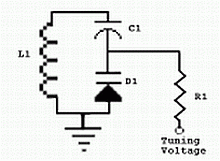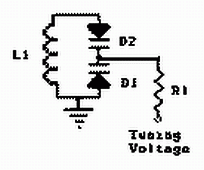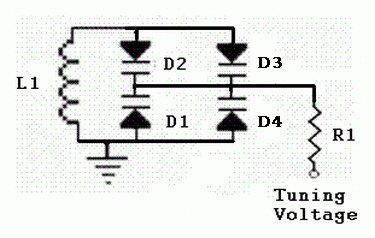|
Varactor Diodes,
INTRODUCTION:
Elmer Teaches Newbie The Basics The
purpose of this page is to provide the "Newbie" to Homebrewing a little
insight into the Varactor
Diode, also called a "Varicap".
First a little background information.
All RF tuned circuits, whether it is an oscillator, an RF amplifier, IF amplifier (just another form of RF amplifier at a fixed frequency) have three elements. Capacitive Reactance, Inductive Reactance and Resistance. In a resonant circuit Capacitive and Inductive reactances are generally considered to be "lossless" as the energy is alternately contained in the capacitor and inductor. There are resistive losses consisting of the normal resistance of wire etc. There is also something called "Dielectric Losses" in the capacitor's dielectric, coil forms and the coil's core, but we won't go into that here. In the "early" days of radio, all variable tuning of oscillators, RF amplifiers, filters etc was done in one of two ways. The first was varying the capacitance with a variable capacitor where the plates of the two halves of the capacitor are meshed in and out. You've probably seen these in old radios. The other and less common way was by varying the inductance of the coil, usually by sliding a slug in and out of the coil's form. This was common in automotive radios, probably because dirt did less damage to the movable coil slug than it would a capacitors plates. Some premium receivers, such as the Military R-390 series also used this method. In "The Good Old Days" the homebrewer had no problem finding a variable capacitor for his homebrew projects. Every junked out table radio had one. NOW, we come up to modern times. It isn't as easy to find a variable capacitor for our homebrew projects. The radio we once junked out so carelessly is now a valued piece of antique electronics. You can still buy "variables" from places like Antique Electronics in Arizona, but they aren't cheap. Old Timers will often gladly dig through their junk box for you, but not everyone has an "Elmer" (Old Timer who helps beginners) to help them. ON THE OTHER HAND: With today's miniature electronics, even if we do have a variable capacitor, it may well be larger than the entire project. HELP!
What is one to do?
Enter modern
electronics to the rescue in the form of a tiny device that often looks
like another transistor. This is the Varactor
Diode.
One of the features of a reverse biased (non conducting) PN junction is
that it electrically looks like a capacitor. I won't go into
the
Physics of it here, but suffice it to say that the capacitance will
change as the Reverse Voltage changes. The HIGHER the
Voltage, the LESS capacitance it has. To make it
easy to remember, think, "As Reverse
Voltage goes UP, Frequency goes UP".
ALL bipolar transistors, rectifier diodes etc exhibit this trait, but aren't predictable in what the actual capacitance value will be, or the tuning range you can get. (But it's handy to know if you're ever in a pinch for a varactor of limited range). Enough of this chatter. Let's drop in at the donut shop as "Elmer" teaches "Newbie" a little about Varactors. **************************************************************************** <Elmer> Lets look at the following circuit, probably about the simplest Varactor tuned circuit one can contrive. 
<Elmer>
This basic circuit is taken from an actual Active E-Field probe
published on the web. It is as basic as one can get, the
tuned circuit
being comprised of one coil and one capacitor (the Varactor).
The
Varactor is the device that looks like a capacitor (two parallel
plates) with an arrow pointing INTO it. The arrow represents the Anode
and in the case of a varactor is ALWAYS biased NEGATIVE in respect to
the Cathode (the parallel lines). This is usually referred to
as "Reverse
Bias" and in this state the diode is not conducting and
there is NO
current flow in the circuit.
<Newbie> "But wait, I see another capacitor labeled C1 that is also in the tank circuit. Where does this enter the picture?" <Elmer> I'm glad you asked. It is there for one purpose only, DC blocking to prevent the POSITIVE tuning Voltage being routed to ground through the coil (from now on we'll call this tuning voltage BIAS for brevity). <Newbie> "This brings up another question. Where does the bias enter the circuit?" <Elmer> The Variable Bias is fed through resistor R1. This resister should have a very high resistance to provide good isolation from the tank circuit and minimize loading and losses. Typically it will be 1 MegOhm or more. <Newbie> "But doesn't that 1 Megohm resistor have an awful lot of Voltage drop? It seems to me like if you started with 6 Volts or so, the diode would see considerably less." <Elmer> Remember your Ohm's Law. To drop a Voltage across a resistance, 1 Megohm in this case, you first have to draw current through it. Since the diode is "REVERSE" biased there isn't any current flow (or very little anyway). Certainly not enough to drop any significant Voltage. In FACT, I often use 2.2 or 3.3 Megohms for that resistor so as to minimize losses and improve circuit "Q" and selectivity. <Newbie> "Ok, sounds EASY. Now I'm going to build my Pre-amp. Anything else I need to know?" <Elmer> YES! Remember, I said this is the simplest Varactor tuned circuit. It DOES have a couple drawbacks. <Newbie> "Oh. What are those?". <Elmer> Remember up towards the top when I said that these Varactors are VOLTAGE tuned? <Newbie> "Yes". <Elmer> Well, the same Voltage tuning that makes it so valuable to us can also cause non-linearities, especially in the presence of strong signals. These non-linearities will cause intermodulation and a mish-mash of signals. Think of it this way. Suppose you're tuned to a relatively low frequency and so have a small bias voltage, perhaps 1 Volt across the diode. You also have a very large antenna to hear that weak beacon down in the South Pacific. BUT, there are also some nice strong local stations that you like to hear the baseball game on. The Voltage induced in your antenna by the strong stations will actually cause the BIAS across the diode to vary along with the signals coming in on your antenna. This means that the CAPACITANCE of the tuned circuit is also varying. If the frequency of the strong station is 550 KHz, the Bias is varying at a 550 KHz rate. But it's far more complicated than that as there are many signals hitting your antenna. <Newbie> "Oh, Uh, what am I going to do then. I sure don't want to build something and not have it work." <Elmer> Glad you asked. Hand me another donut please. Let's look at this somewhat modified circuit below. 
<Newbie> "Uh, two Varactors? But one looks backwards!" <Elmer> Yep, that is the trick. The arrow pointing up actually goes to the coil in the first picture. Think of the second Varactor as replacing capacitor C1 in the first circuit. Now, think a little about what I said before devouring that last donut (Waitress, I need more coffee please). Look at this circuit and think only Capacitors, don't worry about tuning Voltage. What occurs when two Equal value capacitors are in series? What would be the total capacitance if each were 80 pF? <Newbie> "Hmm, the total capacitance is divided by two. I'd have 40 pF! <big grin>" <Elmer> Right, you're catching on! Now, suppose the top capacitor is 70 pF and the bottom one is 90 pF. What is the total? Here, use mine, you should always have a calculator with you. <Newbie> Scratching his head and thinking, punches a few keys. "Uh, it looks like 39.38 pF." <Elmer> Good job! You're right. Now, what if the top capacitor is 90 pF and the bottom one is 70 pF? <Newbie> "Why, since they're in series there wouldn't be any change. I'd still have 39.38 pF." <Elmer> You'll go far. Now, let's apply our Bias and assume we have a total series capacity of 100pF. A nice strong signal is hitting our antenna. What effect is this signal going to have on the total capacity of the Varactors? THINK!! "Waitress, more coffee please, oh, and maybe a Cheese Danish for my young friend, he's burning the calories this morning". <Newbie> Scratching his head, doodles on the napkin awhile. "Why, it won't have any effect, or at least I don't think it will. Does this mean I won't get a lot of junk from strong broadcasters on the beacon I want to hear?" <Elmer> Right! As the signal voltage across the tuned circuit varies with the applied signal, the bias across one increases as the bias across the other decreases. This tends to keep the total capacitance of the diode group pretty much constant. There may be some non-linearities, but circuit performance is greatly improved. I
think that's enough study for one day. The sun has come out
and I need to go home and mow the lawn.
<Newbie> "Good, I want to go home and order a pair of NTE618 Varactors for my Preamplifier." <Elmer> WHOA THERE YOUNG MAN! What was the tuning capacity called for in that Preamp article? <Newbie> "The Plans specified a variable with a maximum capacity of 365 to 450 pF. The NTE618 is good for 440pF or so. Why?" <Elmer>. Think what you just said, then look at that circuit again. What is the maximum capacity two NTE618's will give you there? <Newbie> "Oh, I see. Like two capacitors in series, the maximum value is halved. I'll only have about 220 pF maximum." What Varactor will give me 800 or so pF each?" <Elmer> None that I'm aware of. However, don't feel bad. The circuit will still work. You just need four Diodes in a series/parallel arrangement. Yes, it costs 4 times as much as the single diode circuit, but the results are well worth it! Let's look at this next drawing. It's fairly straight forward and I think you'll get the idea. 
I
want you
to look at this circuit and tell me how and why it works.
Explain
where the bias Voltage enters and the return route for it.
Now, if you
get it right I'm paying for our breakfast. If not, well. . .
<Newbie>
Sipping his cold coffee and scratching his chin. "Hmm, I see
we have 4
Varactors here. If I group them in two parallel pairs, I
should see a
MAXIMUM of about 880 pF for each pair. Now, since there are
two pairs
in series, that will halve the total. Hey, I'll have my
maximum 440
pF. Um, the Bias or Tuning Voltage Path. I'd have
to say the tuning
Voltage is applied through resistor R1. Return
Path, let me see. Each
of the Varactors has a path to ground. Two through
the coil, the
other two directly to ground Is that what you mean by return
path?"
<Elmer> Yes. Remember, there must ALWAYS be a return path to ground for the other side of the Varactor diode. Sometimes it isn't as apparent as it is with these simple tuned circuits. Occasionally you will have to add a high value resistor to ground to complete the circuit. In those cases, use a value high enough that it doesn't load the circuit down. No, I don't have time to go into that today. Have fun! <Newbie>. Thank you for the breakfast. Next time it'll be my treat. Copyright notice: All material on this page is copyrighted 2004-2007 by Philip Atchley, KO6BB. Permission is granted to use it for non-commercial purposes so long as proper credits are given and the owner is notified via Email at. . . beaconeer-at-sbcglobal-dot-net |

